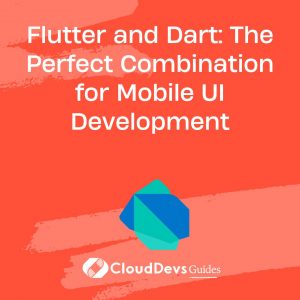Flutter and Dart: The Perfect Combination for Mobile UI Development
In the ever-evolving landscape of mobile app development, finding the right tools and technologies is crucial to creating remarkable user experiences. In this journey, Flutter and Dart have emerged as a dynamic duo that’s transforming the way mobile UIs are crafted. The synergy between these two technologies has taken the development world by storm, enabling developers to build stunning, performant, and consistent user interfaces across various platforms.
Table of Contents
1. Unveiling Flutter and Dart
Before delving into the prowess of their combination, let’s take a brief look at what Flutter and Dart are individually.
1.1. Flutter: A Canvas for Creativity
Flutter, developed by Google, is an open-source UI software development kit that aids in building natively compiled applications for mobile, web, and desktop from a single codebase. What sets Flutter apart is its widget-based architecture that empowers developers to create visually stunning and expressive UIs. With a rich set of pre-designed widgets, developers can seamlessly compose intricate user interfaces while maintaining pixel-perfect precision across platforms. Flutter’s “hot reload” feature speeds up the development process, allowing real-time adjustments and instant previews of changes made in the code.
1.2. Dart: The Backbone of Flutter
Dart, also developed by Google, is the programming language that drives Flutter. Dart is designed to be efficient, flexible, and easy to learn, making it an ideal choice for mobile app development. Its object-oriented nature and strong type system help catch errors at compile-time, reducing the likelihood of runtime crashes. Dart’s Just-In-Time (JIT) compilation enables rapid development cycles, while Ahead-Of-Time (AOT) compilation results in optimized performance for production applications.
2. The Synergy Unleashed
Now that we have a basic understanding of Flutter and Dart, let’s explore why they form the perfect combination for mobile UI development.
2.1. Consistency Across Platforms
One of the most significant advantages of using Flutter and Dart is the ability to create consistent user interfaces across different platforms. Flutter’s widget-based approach allows developers to create a single codebase for both iOS and Android applications. This eliminates the need to maintain separate codebases for each platform, reducing development time and effort. Whether it’s a button, text input, or complex layout, Flutter’s widgets adapt to the platform’s design guidelines, ensuring a cohesive user experience.
dart
// Flutter widget example
Widget build(BuildContext context) {
return Scaffold(
appBar: AppBar(title: Text('Flutter Example')),
body: Center(child: Text('Hello, Flutter!')),
);
}
2.2. Expressive UI Creation
Flutter’s rich set of customizable widgets empowers developers to create UIs that are not only functional but also visually appealing. The flexibility offered by Flutter widgets allows for easy customization and branding, ensuring that the app’s design aligns with the brand identity. From simple animations to complex transitions, Flutter’s widget library provides the building blocks for creating engaging user interfaces.
dart
// Custom widget example
class CustomButton extends StatelessWidget {
final String text;
CustomButton(this.text);
@override
Widget build(BuildContext context) {
return ElevatedButton(
onPressed: () => print('$text button pressed'),
child: Text(text),
);
}
}
2.3. Rapid Development with Hot Reload
Flutter’s “hot reload” feature is a game-changer for developers. It allows real-time code changes to be instantly reflected in the running app, providing immediate feedback without the need to restart the app. This speeds up the development process significantly, making it easier to iterate and experiment with different UI elements, layouts, and functionalities.
dart
// Hot reload example
void main() {
runApp(MyApp());
}
class MyApp extends StatelessWidget {
@override
Widget build(BuildContext context) {
return MaterialApp(
home: Scaffold(
appBar: AppBar(title: Text('Hot Reload Example')),
body: Center(child: Text('Try changing this text!')),
),
);
}
}
2.4. Performance and Optimization
Flutter’s use of Dart brings performance benefits to mobile app development. Dart’s AOT compilation ensures that Flutter apps are highly optimized, resulting in faster startup times and smoother animations. Additionally, Flutter’s reactive framework only rebuilds the necessary parts of the UI when changes occur, reducing unnecessary rendering and enhancing overall performance.
dart
// Performance optimization example
class ItemList extends StatelessWidget {
final List<String> items;
ItemList(this.items);
@override
Widget build(BuildContext context) {
return ListView.builder(
itemCount: items.length,
itemBuilder: (context, index) {
return ListTile(title: Text(items[index]));
},
);
}
}
2.5. Access to Native Features
While Flutter offers a rich set of widgets and libraries, there might be instances where direct access to platform-specific features is required. Dart’s interoperability with native code allows developers to easily integrate native functionalities into Flutter apps. This ensures that the app can harness the full power of the underlying platform while maintaining a consistent user interface.
dart
// Platform channel example (iOS/Android specific code)
Future<void> launchMap() async {
const platform = MethodChannel('com.example.map_launcher');
try {
await platform.invokeMethod('launchMap', <String, dynamic>{
'latitude': 37.7749,
'longitude': -122.4194,
});
} on PlatformException catch (e) {
print('Failed to launch map: ${e.message}');
}
}
Conclusion
The pairing of Flutter and Dart has revolutionized mobile UI development, offering a seamless blend of expressive design and high-performance execution. Flutter’s widget-based architecture simplifies UI creation and fosters consistency across platforms, while Dart’s efficiency and strong type system enhance development speed and reliability. Whether you’re a seasoned developer or a newcomer to the mobile app scene, exploring the capabilities of Flutter and Dart will undoubtedly enhance your ability to craft captivating and dynamic user interfaces. Embrace this perfect combination and embark on a journey to create exceptional mobile experiences that captivate and engage users across the globe.
Table of Contents








